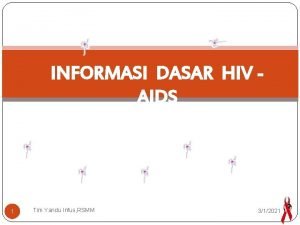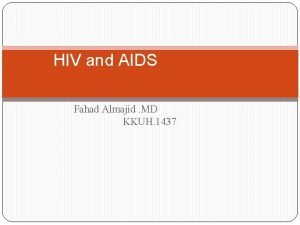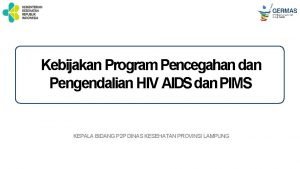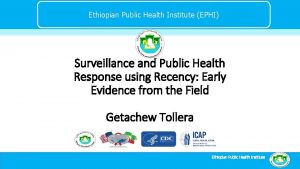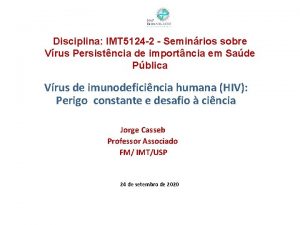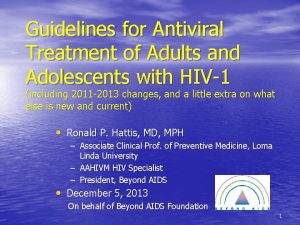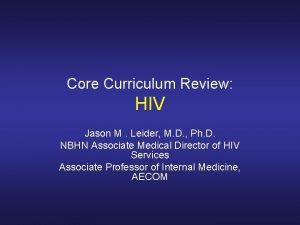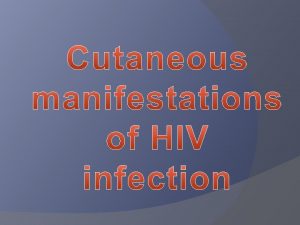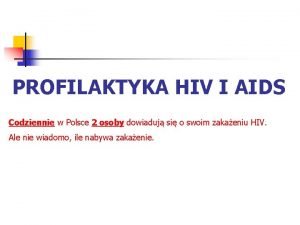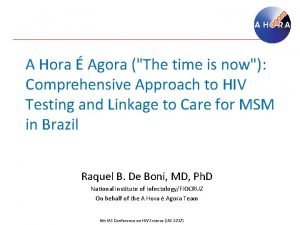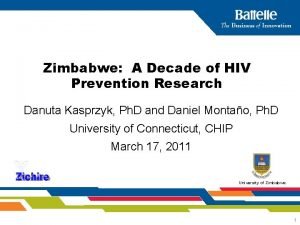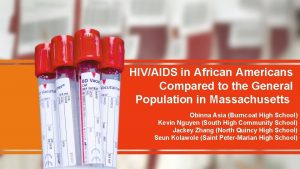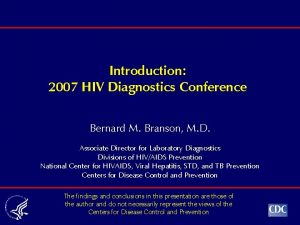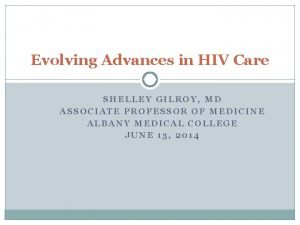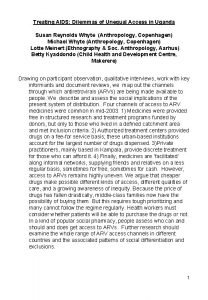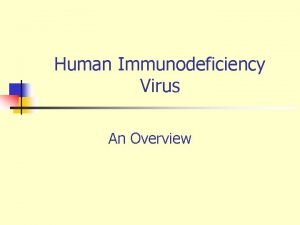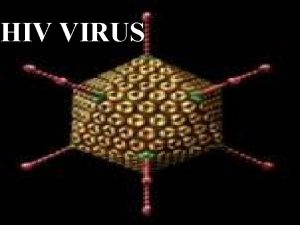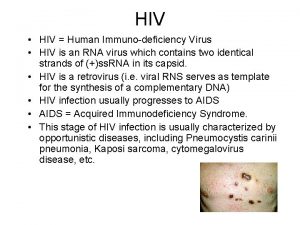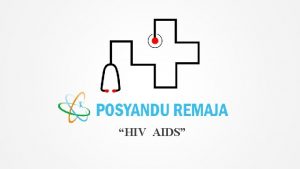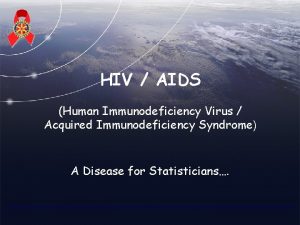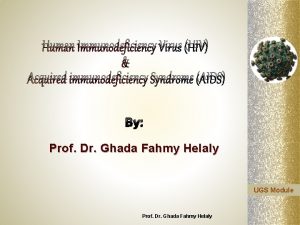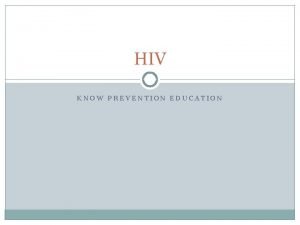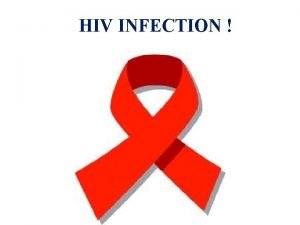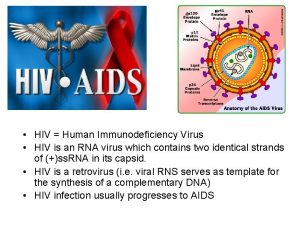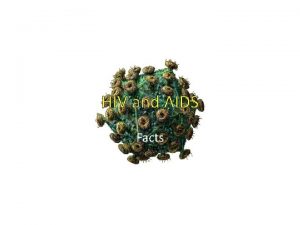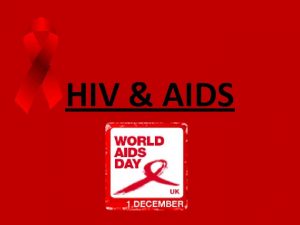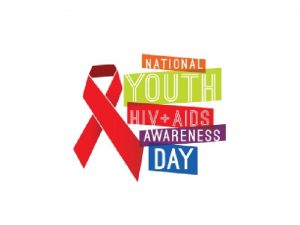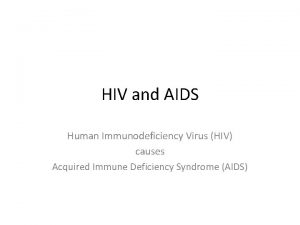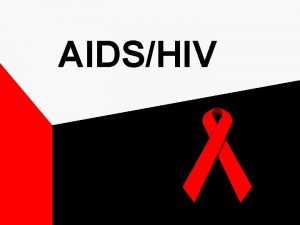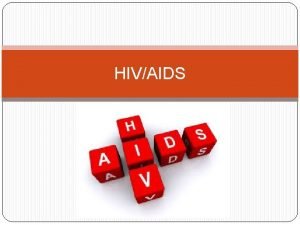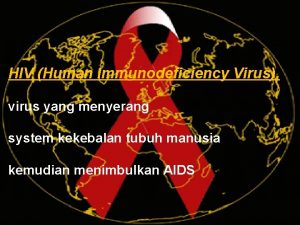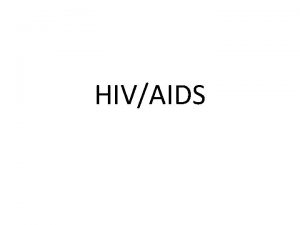HIV Human Immunodeficiency Virus is the virus that









































- Slides: 41


• HIV (Human Immunodeficiency Virus) is the virus that attacks the immune system, making it difficult for the body to combat infectious diseases. • AIDS (Acquired Immune Deficiency Syndrome) is the last and most severe stage of HIV infection. • AIDS is officially classified when the T-Cell count drops below 200 (normal T-Cell count 500).

Fluids that CAN transmit HIV Fluids that CAN NOT transmit HIV • Blood • Sweat • Semen • Urine • Vaginal Secretions • Feces • Breast Milk • Saliva • Tears

HIV Virus under magnification.


Bacterial Infections Chancroid Chlamydia Gonorrhea Syphilis

Treatment All bacterial infections can be treated with antibiotics Must take the full dosage usually 10 days to ensure that the bacteria is completely killed Symptoms may start to get better with as few as 4 or 5 treatments but keep using it Disease can re infect the person as often as to the exposure meaning if you keep having sex with infected people you continue to become infected

A sexually transmitted disease that produces a painful ragged ulcer at the site of infection, caused by a bacteria.

• Chancroid is spread by sexual contact with an infected individual. • The bacteria are more likely to invade the sexual organs at the point of a pre-existing injury, such as a small cut or scratch. • The likelihood of transmission is greater if a person is very active sexually and does not practice personal hygiene.

• Chlamydia is a bacterial infection that is spread through sexual contact with an infected person. • Chlamydia is the most commonly reported STD in the United States.

• Chlamydia is spread through sexual contact. This includes penis to vagina or penis to rectum contact. • It can also be passed from the mother to her newborn during birth. • An estimated 2. 8 million infections occur annually in the U. S. Women are frequently re-infected if their sex partners are not treated.

• Signs and Symptoms : • Chlamydia is known as a "silent" disease because the majority of infected people have no symptoms. If symptoms do occur, they usually appear within 1 to 3 weeks after exposure. • Women who have symptoms might have an abnormal vaginal discharge or a burning sensation when urinating • Men with signs or symptoms might have a discharge from their penis or a burning sensation when urinating. Men might also have burning and itching around the opening of the penis.

• Gonorrhea is caused by a bacterium that can grow and multiply easily in the warm, moist areas of the reproductive tract, including the: • Cervix • Uterus • Fallopian Tubes • Urethra (women and men). • The bacterium can also grow on or inside the mouth, throat, eyes, anus and skin.

• Gonorrhea is spread through contact with the penis, vagina, mouth, or anus. • Ejaculation does not have to occur for gonorrhea to be transmitted or acquired. Gonorrhea can also be spread from mother to baby during delivery. • CDC estimates that more than 700, 000 persons in the U. S. get new gonorrheal infections each year. Less than half of these infections are reported to CDC. • ** People who have had gonorrhea and received treatment may get infected again if they have sexual contact with an infected person.

• Signs and Symptoms: • Some men with gonorrhea may have no symptoms at all. However, some men have signs or symptoms that appear one to fourteen days after infection. Symptoms and signs include a burning sensation when urinating, or a white, yellow, or green discharge from the penis. Sometimes men with gonorrhea get painful or swollen testicles.

Gonorrhea • Signs and Symptoms continued • In women, the symptoms of gonorrhea are often mild, but most women who are infected have no symptoms. Even when a woman has symptoms, they can be so non -specific as to be mistaken for a bladder or vaginal infection. • The initial symptoms and signs in women include a painful or burning sensation when urinating, increased vaginal discharge, or vaginal bleeding between periods.

• Syphilis is a sexually transmitted infection caused by bacteria. • It has often been called “the great imitator” because so many of the signs and symptoms are indistinguishable from those of other diseases.

• Syphilis is spread by sexual contact with an infected individual. • Transmission by sexual contact requires exposure to moist lesions of skin or mucous membranes.

• Limit your number of sex partners. • Use a male or female condom. ** • If you think you are infected, avoid sexual contact and visit your local STI clinic, a hospital or your doctor. • Notify all sexual contacts immediately so they can obtain examination and treatment. • All pregnant women should receive at least one prenatal blood test for syphilis. ** Remember that use of condoms may prevent the disease if the initial contact sore is on the penis or in the vaginal area. However, transmission can occur if the sore is outside the areas covered by the condom.

Viral Infections Herpes HIV/AIDS HPV – Genital Warts

• Herpes simplex virus type 1 (HSV-1) is usually associated with infections of the lips, mouth, and face. • It is the most common herpes simplex virus and most people develop it in childhood. • HSV-1 often causes lesions inside the mouth, such as cold sores (fever blisters).

• HSV-1 is transmitted by contact with infected saliva. • Sharing Chap-Stick, water bottles, and kissing can spread the virus.

• Preventing herpes simplex is difficult since people can spread the virus even when they don't have any symptoms of an active outbreak. • Avoiding direct contact with an open lesion will lower the risk of infection. • People with active herpes lesions should also avoid contact with newborns, or people with suppressed immune systems, because these groups are at higher risk for more severe disease.

• Herpes simplex virus type 2 (HSV-2) is a sexually transmitted viral infection, which often produces painful sores, usually in the genital area. • Once infected, an individual may carry the virus and be subject to recurrent bouts of infection for life. • Some estimate that as many as 20 percent of the adult population in the United States has been exposed to the virus.

• HSV-2 is spread during sexual contact with an infected person who is secreting the virus in fluids from lesions or mucous membranes. • Nationwide, 16. 2%, or about one out of six, people 14 to 49 years of age have genital HSV-2 infection. • People diagnosed with a first episode of genital herpes can expect to have several (typically four or five) outbreaks (symptomatic recurrences) within a year. Over time these recurrences usually decrease in frequency.

• Avoidance of sexual contact with individuals who are showing symptoms is an immediate, but only partial answer because the herpes virus may be shed while the infected individual shows no symptoms. • Cesarean section is often recommended when primary or recurrent herpes II lesions occur in late pregnancy. • Sexual relations should be approached responsibly. • Limit the number of your sex partners. • Use a male or female condom. • If you think you are infected, avoid any sexual contact and visit the local STI clinic, a hospital or your doctor.

• Genital warts are caused by the human papillomavirus (HPV) that affects the skin or mucous membranes. • The virus may cause cauliflower-like fleshy growths in moist areas in and around the sex organs. • In many cases, warts are not visible to the naked eye.

• Genital warts are generally spread through direct skin-to-skin contact during vaginal, anal and oral sex with someone who is infected. • HPV can also be spread from mother to child (usually found in the child's throat or mouth) during birth.

• Limit your number of sex partners. • Use a male or female condom**. • Carefully wash genitals after sexual relations. • If you think you are infected, avoid sexual contact and visit your local STI clinic, a hospital or your doctor. • Notify all sexual contacts immediately so they can obtain examination and treatment. ** Remember that use of condoms may prevent the virus from coming in contact with susceptible skin areas. However, since HPV can infect the scrotum and vulva, transmission can occur outside condom-covered areas.

HPV Vaccine Two vaccines are available to prevent the human papillomavirus (HPV) types that cause most cervical cancers. One of the HPV vaccines, Gardasil, also prevents genital warts as well as anal, and vaginal cancers. Both vaccines are given in 3 shots over 6 months. cdc. gov

Which girls &boys/women & men should receive HPV vaccination? HPV vaccination is recommended with either vaccine for 11 and 12 year-olds. It is also recommended for people 13 through 26 years of age who have not yet been vaccinated or completed the vaccine series; HPV is the most common STI in America today. An estimated 75%to 80% of males and females will be infected with HPV in their lifetime. 6 million new cases of genital HPV* in the United States each year. It’s estimated that 74% of them occur in 15 - to 24 -year-olds. cdc. gov

• Limit your number of sex partners. • Use a condom. • Carefully wash the genitals after sexual relations. • If you think you are infected, avoid any sexual contact and visit your local STI clinic, a hospital or your doctor. • Notify all sexual contacts immediately so they can obtain examination and treatment.

• Pelvic inflammatory disease (PID) is a general term that refers to infection of the uterus, fallopian tubes, and other reproductive organs. • It is a common and serious complication of some sexually transmitted infections, especially chlamydia and gonorrhea. • PID can damage the fallopian tubes and tissues in and near the uterus and ovaries. • Untreated PID can lead to serious consequences including infertility, ectopic pregnancy, infection, and chronic pelvic pain.

• PID occurs when bacteria move upward from a woman's vagina or cervix (opening to the uterus) into her reproductive organs. • Sexually active women in their childbearing years are most at risk, and those under age 25 are more likely to develop PID than those older than 25. This is because the cervix of teenage girls and young women is not fully matured, increasing their susceptibility to the STDs that are linked to PID.

• Women who douche may have a higher risk of developing PID compared with women who do not douche. • Women who have an intrauterine device (IUD) inserted may have a slightly increased risk of PID near the time of insertion compared with women using other contraceptives or no contraceptive at all. However, this risk is greatly reduced if a woman is tested and, if necessary, treated for STDs before an IUD is inserted.

• Limit your number of sex partners. • Use a male or female condom. • If you think you are infected, avoid sexual contact and visit your local STI clinic, a hospital, or your doctor. • Notify all sexual contacts immediately so they can obtain examination and treatment (for STI infection). • CDC recommends yearly chlamydia testing of all sexually active women age 25 or younger and of older women with risk factors for chlamydial infections (those who have a new sex partner or multiple sex partners).

☼ Abstinence is the only 100% sure way not to get pregnant or become infected with an STI. ☼ No need to worry about or purchase birth control. ☼ Abstinence does not go against religious beliefs or teachings. ☼ Abstinence helps to prevent emotional injury. ☼ Abstinence promotes respect for yourself and others.


Abstinence benefits Stronger relationship build on more than sex Allows you to plan for a healthier sexual lifestyle Allows you to obtain personal goals in life Prevents decision making under pressure If and when you are ready you can change your decision to have an active sex life

Focus more on: ☼ Family: • Developing better relationships with parents & siblings. • Spending time with parents & siblings. • Open communication with parents and siblings. ☼ ☼ School: • Developing a high level of school connectedness. • Improving your attendance. • School-related activities (extracurricular). Individual: • Improving your GPA. • Developing a personal commitment to abstinence until marriage. • Developing feelings of self-respect and self-worth.

References: Centers for Disease Control and Prevention (CDC), (December 13, 2006). General information - STD information from CDC. Retrieved November 2, 2007, from Centers for Disease Control and Prevention Sexually Transmitted Diseases Web site: http: //www. cdc. gov/nchstp/dstd/disease_info. htm Dermnet, (2007). Herpes, HPV and other STDs. Retrieved November 2, 2007, from Dermnet Skin Disease Image Atlas Web site: http: //www. dermnet. com/module. Index. cfm? module. ID=16 Hardin MD, (Oct 31, 2007). Hardin MD medical gallery pictures hosted on the Hardin MD site. Retrieved November 2, 2007, from Hardin MD Medical Gallery Web site: http: //www. lib. uiowa. edu/hardin/md/gallery 2. html Herpes-coldsores. com, (2007). Chlamydia Pictures. Retrieved November 2, 2007, from Sexually Diseases Web site: http: //www. herpes-coldsores. com/std/chlamydia_pictures. htm Transmitted Lickona, T. (2007). 10 Emotional dangers of premature sexual involvement. The Fourth and Fifth Rs: Respect and Responsibility. 13, 1 -6. National Institutes of Health , (2007, 06 05). Medline. Plus Medical Encyclopedia. Retrieved November 5, 2007, from Medline. Plus Web site: http: //www. nlm. nih. gov/medlineplus/encyclopedia. html New York State Department of Health, (2007, 10). Communicable Disease Fact Sheets. Retrieved November 2, 2007, from New York State Department of Health Web site: http: //www. health. state. ny. us/diseases/communicable/#g Obgyn. net, (2007). OBGYN_net diagnostic laparoscopy in gynaecological problems a retrospective study-Tabbakh, MD. Retrieved November 2, 2007, from Laparoscopy & Hysteroscopy Web site: http: //www. obgyn. net/hysteroscopy. asp? page=/hysteroscopy/articles/dxlap N_El
 Secondary immunodeficiency diseases
Secondary immunodeficiency diseases Severe combined immunodeficiency
Severe combined immunodeficiency Stadium hiv menurut who
Stadium hiv menurut who Hiv virus
Hiv virus Tìm vết của mặt phẳng
Tìm vết của mặt phẳng Sau thất bại ở hồ điển triệt
Sau thất bại ở hồ điển triệt Thơ thất ngôn tứ tuyệt đường luật
Thơ thất ngôn tứ tuyệt đường luật Hãy nói thật ít để làm được nhiều
Hãy nói thật ít để làm được nhiều Thơ thất ngôn tứ tuyệt đường luật
Thơ thất ngôn tứ tuyệt đường luật Tôn thất thuyết là ai
Tôn thất thuyết là ai Phân độ lown
Phân độ lown Chiến lược kinh doanh quốc tế của walmart
Chiến lược kinh doanh quốc tế của walmart Gây tê cơ vuông thắt lưng
Gây tê cơ vuông thắt lưng Block nhĩ thất cao độ
Block nhĩ thất cao độ Notifikasi pasangan adalah
Notifikasi pasangan adalah Hiv test window period
Hiv test window period Hiv
Hiv Hiv case-based surveillance in ethiopia
Hiv case-based surveillance in ethiopia Chapter 24 sexually transmitted diseases and hiv/aids
Chapter 24 sexually transmitted diseases and hiv/aids Ciclo do hiv
Ciclo do hiv Hiv
Hiv Window period hiv
Window period hiv Hiv
Hiv Murder by hiv
Murder by hiv Tabela perímetro cefálico por idade
Tabela perímetro cefálico por idade Hiv lifecycle
Hiv lifecycle Hiv
Hiv Brainpop
Brainpop Received oral from hiv positive
Received oral from hiv positive Causative organism of hiv/aids
Causative organism of hiv/aids Objawy hiv
Objawy hiv Hora de agora
Hora de agora Hiv in adults
Hiv in adults Ibase hiv
Ibase hiv Hiv risk factors
Hiv risk factors Hiv family name
Hiv family name Hiv diagnostics conference
Hiv diagnostics conference Prognas akreditasi terbaru 2021
Prognas akreditasi terbaru 2021 Vidas hiv duo ultra package insert
Vidas hiv duo ultra package insert Hiv diagnosis algorithm
Hiv diagnosis algorithm Arv copenhagen
Arv copenhagen Stadium hiv
Stadium hiv


